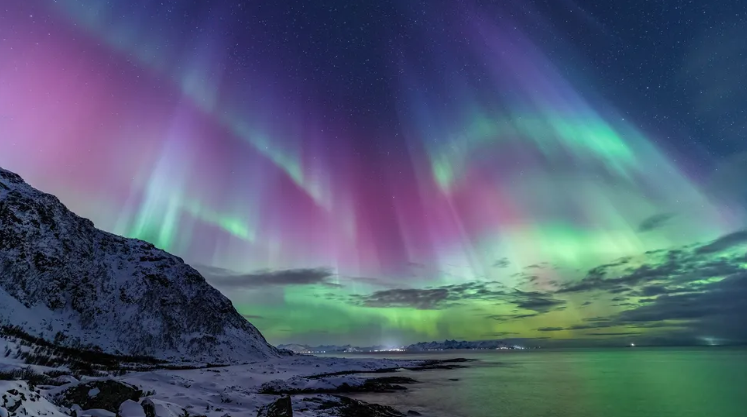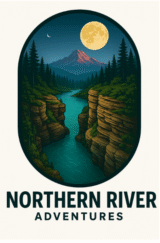
The Aurora Borealis — also known as the Northern Lights — is one of the most captivating natural phenomena on Earth. It dances across polar skies in brilliant greens, purples, pinks, and sometimes even reds, drawing travelers, photographers, and stargazers from around the globe. But what exactly causes this celestial display? Where can you see it? When is the best time to go? And how can you witness it without spending a fortune or braving dangerous conditions?
This guide answers all of those questions and more. Whether you’re planning your first northern lights trip or just want to understand the science and culture behind the glow, this is your complete deep dive into the magic of the aurora borealis.
🌠 What Is the Aurora Borealis?
The aurora borealis is a natural light show caused by the interaction of solar particles with Earth’s magnetic field and atmosphere. These solar particles — mostly electrons — come from solar wind emitted by the sun. When they reach Earth, they collide with atoms in the upper atmosphere, exciting them and causing them to emit light.
This light is what we see as the aurora. Depending on the type of gas involved and the altitude of the collision, the aurora can appear green (oxygen at lower altitudes), red (oxygen at high altitudes), blue or purple (nitrogen), or even pink.
While often romanticized in photos, auroras can vary from faint wisps to full-sky spectacles. They may pulse, ripple, form arcs, or explode in spirals of light — each display is unique.
🌎 Where Can You See the Aurora Borealis?
The aurora is most visible in high-latitude regions around the Arctic — a zone often called the “auroral oval.” Some of the best places to view it include:
- Norway (Tromsø, Lofoten Islands)
- Sweden (Abisko National Park)
- Finland (Lapland)
- Iceland (entire island)
- Greenland
- Canada (Yukon, Northwest Territories, Nunavut, Alberta)
- Alaska (Fairbanks is a major hotspot)
- Scotland (on rare occasions)
In North America, you can even catch the aurora in the northern U.S. states like Montana, North Dakota, Minnesota, Maine, and Michigan, especially during strong geomagnetic storms.
🕒 When Is the Best Time to See the Northern Lights?
While auroras can occur year-round, they are only visible in dark skies. That’s why the best time to see them is during the fall, winter, and early spring months (September to April), especially between:
- 10:00 PM to 2:00 AM local time
- On clear, cloudless nights
- During new moon phases when the sky is darkest
Solar activity also plays a big role. The sun follows an 11-year solar cycle with peaks and valleys in activity. 2024 to 2026 is expected to be a solar maximum period — ideal for aurora watching.
There are also geomagnetic indices and forecasts, such as:
- Kp index (scale of 0 to 9, where 5+ can bring auroras to lower latitudes)
- Aurora forecast maps from NOAA and other scientific agencies
🔭 How to Prepare for an Aurora Viewing Trip
Seeing the northern lights is not like visiting a museum — you need patience, preparation, and flexibility. Here’s what to consider:
1. Location is Key
Choose a dark sky area with minimal light pollution. National parks, rural lodges, or wilderness areas work best.
2. Time it Right
Plan your trip around peak aurora seasons, avoiding full moons and prioritizing nights with clear weather.
3. Gear Up for the Cold
Expect temperatures to drop — sometimes severely. Bring:
- Thermal layers
- Down jacket
- Waterproof boots
- Gloves, hat, and neck warmer
- Tripod and camera (if photographing)
4. Stay Up Late
Auroras often appear after midnight. Take naps during the day and bring warm drinks or snacks to keep your energy up.
5. Use Tech to Help
Apps and websites can give real-time forecasts. Popular ones include:
- My Aurora Forecast (app)
- Aurora Alerts
- NOAA Space Weather Prediction Center
📸 Tips for Photographing the Northern Lights
Want to capture the aurora on camera? It’s doable — even with entry-level gear. Follow these tips:
- Use a tripod: Essential for long exposures
- Set to manual mode: Control ISO, shutter, aperture
- Shutter speed: 5 to 20 seconds depending on brightness
- ISO: 800–3200
- Aperture: f/2.8 or wider
- Focus: Manual to infinity
Practice before your trip so you’re ready when the sky lights up. Bring spare batteries — cold drains them fast.
🌌 Cultural Significance of the Northern Lights
The aurora has held spiritual and cultural meaning across centuries:
- Inuit legends speak of spirits dancing or playing games in the sky.
- Norse mythology saw the lights as reflections from Valkyrie armor.
- In Finland, it was said the lights were caused by a fox sweeping snow into the sky with its tail — hence the word revontulet (“fox fires”).
- In China, they were viewed as celestial dragons.
Some cultures feared them as omens, while others believed they were a bridge to the afterlife. Today, they continue to inspire awe and connection to something greater.
🏕️ Best Aurora Viewing Lodges & Destinations
If you’re looking for an unforgettable trip, these destinations combine comfort, access, and high aurora frequency:
- Kakslauttanen Arctic Resort (Finland) – Glass igloos under the aurora
- Aurora Village (Canada) – Heated viewing domes in Northwest Territories
- Hotel Rangá (Iceland) – Luxury with aurora alerts
- Borealis Basecamp (Alaska) – Clear-roofed domes near Fairbanks
- Abisko Sky Station (Sweden) – Considered one of the world’s best viewing spots
You don’t have to break the bank either. Budget-friendly cabins and campsites exist in every region. Just be sure to research your area’s aurora potential.
🧠 Fun Aurora Facts You Might Not Know
- Auroras happen on other planets too, including Jupiter and Saturn!
- The southern lights (aurora australis) occur near the South Pole and are just as beautiful.
- Auroras can affect radio communications and satellites.
- The loud “crackling” sound reported by some viewers is still being studied — possibly static discharges in Earth’s magnetic field.
- Red auroras are rare, and tend to occur at very high altitudes.
✨ How to Make the Most of Your Northern Lights Trip
- Don’t stress if you don’t see them the first night. Stay several days to improve your chances.
- Enjoy the full experience: dogsledding, snowshoeing, local cuisine, and hot springs.
- Meet locals — they often have the best viewing tips.
- Take time to reflect. There’s nothing like standing under a glowing sky to feel reconnected with nature.
The aurora borealis is more than just a pretty light show. It’s a reminder of how connected we are — to the sun, to the planet, to each other. Witnessing it firsthand is one of those rare experiences that doesn’t just meet expectations — it exceeds them.
So whether you plan a guided adventure or a solo trip, remember: it’s about more than the lights. It’s about chasing wonder.
🧡 Support the Journey
We’re here to help outdoor dreamers like you discover magical places and plan unforgettable adventures.
📥 Subscribe to Northern River Adventures to get new destination guides, outdoor living tips, and adventure inspiration — straight to your inbox.
📌 Pin or share this guide with anyone dreaming of chasing the lights.
